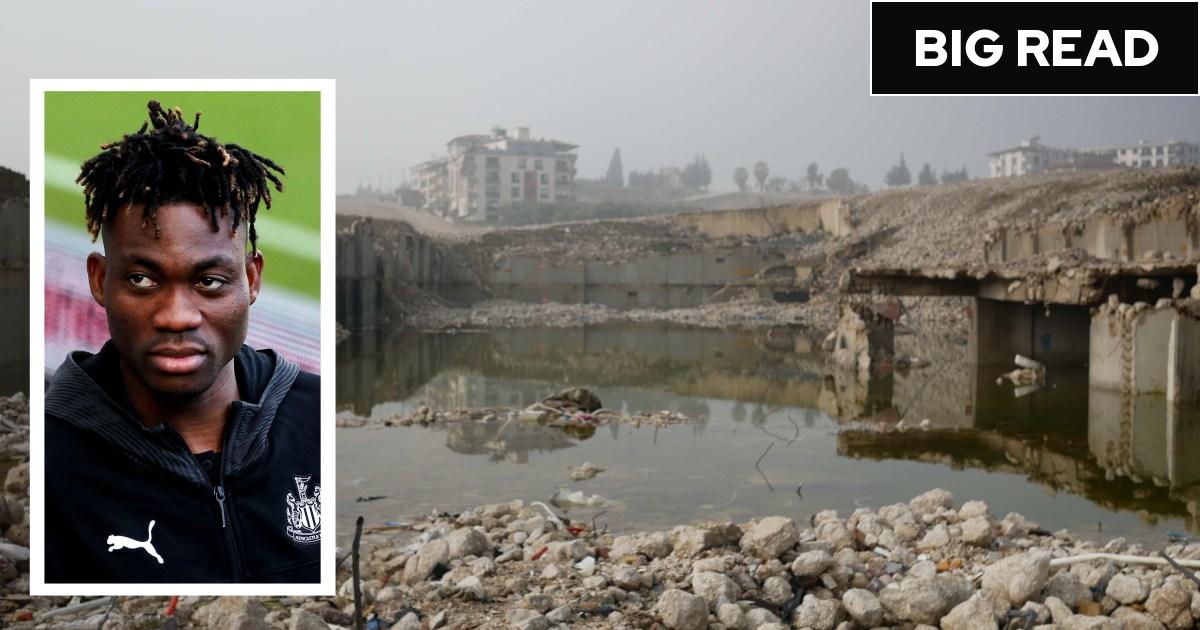Human remains still lie under the rubble of Renaissance Residences, a year after the luxury tower block collapsed during the earthquakes which struck Turkey and Syria last year.
An estimated 750 people, living across 249 flats billed as a “paradise”, died in the wreckage, with dozens still not recovered.
One of those who lost his life in Renaissance Residences was former Premier League footballer Christian Atsu, who spent his career at clubs including Newcastle, Everton and Chelsea.
A year on, the question remains: how did a luxury apartment block, built just 12 years before, turn into a mass grave?
Atsu had moved into Renaissance Residence just five months before the earthquake, after signing with club Hatayspor in Antakya, Turkey in September 2022.
The building was billed as one of Antakya’s finest new homes, replete with a swimming pool, shops and a gym, and opened by a group of local and national politicians.
The night before the earthquake, on 5 February, 2023, Atsu had scored the winning goal in a match against Kasimpasa, with his family calling afterwards to congratulate him.
Then, at 4.17am, disaster struck.
A 7.8 magnitude earthquake hit Syria and Turkey; witnesses said the building withstood 40 seconds of violent shaking before folding sideways and collapsing to the ground.
The 31-year-old’s body was recovered from the rubble an agonising 11 days later.

The apartment block’s collapse has become a symbol of the institutional failings in Turkey’s building system, with concerns about rife corruption leading to widespread non-compliance with safety standards.
The Renaissance’s developer, Mehmet Yaşar Coşkun, was arrested at Istanbul airport as he tried to leave the country and is now being sued. An expert report prepared as part of the indictment cited poor quality concrete as among the causes of the collapse.
Mr Coşkun told prosecutors he did not know why the Renaissance had collapsed and insisted the build had followed all required regulations. He also said that the fact that the building collapsed on its side rather than inwards was evidence it had been built solidly.
David Alexander, professor of emergency planning and management at UCL who has spent time assessing buildings in Turkey, said there is “no doubt whatsoever” that thousands of lives could have been saved on 6 February had buildings been safer.
“You only need to look at Japan, where I have just been in a magnitude 6.8 earthquake. We were in a coffee shop and people didn’t even stop reading the newspaper,” he said.
“I was also in a magnitude 6.8 earthquake of similar characteristics in southern Italy in 1980. It killed 3,000, injured 9,000, made 280,000 homeless and took the roof of the house I was living in. Places like Japan and Chile have really got to grips with the engineering side of this.”
Iman Hajirasouliha, professor of structural engineering at the University of Sheffield and leader of the Earthquake Engineering Group, also said that had building safety protocols been followed, buildings “would be safe at least at the level of protecting people’s lives”.

Over the last 25 years, every earthquake in Turkey has involved mass destruction of new or very modern buildings, according to Professor Alexander.
“People in Turkey live in multiple storey, multiple occupants part of the blocks. And it is these that collapse in vast numbers. You can see it in the Izmit earthquake of 1999, of which there were more than 17,000 deaths,” he said.
“You could see it in the Izmir earthquake during the pandemic. You can see it in last February’s multiple earthquakes. The reason for that is shoddy building.”
Turkey has had earthquake resistant building codes since 1930s, with the last update around six years ago.
There has been a map of the hazardessness of earthquakes in Turkey since 1967, and there is a “lively” academic scene within the country studying “just about every aspect” of earthquakes.
“There’s no way that we can say oh, we didn’t know. Of course we do. Extremely well,” he said.

But cost and allegations of corruption are feared to be hindering progress towards earthquake-proof environments.
“Turkey’s got good building codes, but if you ignore them you could save 10 per cent or more on building costs. What we don’t see is enforcement,” said Professor Alexander.
“I think the problem is essentially corruption. There’s one study by some people from Florida Atlantic University which looked at 340 variables and the 20 most seismically active countries in the world. What they found was that the one variable that explained earthquakes as disasters was the level of corruption.”
In Turkey, so-called “construction amnesties” exist, which effectively legalise buildings which don’t meet earthquake construction standards providing developers pay a fine.
Up to 75,000 buildings in the earthquake zone have been given amnesties, according to the Union of Chambers of Turkish Engineers and Architects’ Chamber of City Planners.
New build apartment blocks – like the Renaissance Residence – were among the buildings filmed collapsing during the deadly quake last year. New builds are required to adhere to updated safety standards from 2018 which added additional structural requirements in earthquake prone areas.

Questions have also been raised about government oversight on the construction industry; in the years immediately following the election of President Recep Tayyip Erdogan in 2003, government permits for housing construction tripled.
President Erdogan has defended the use of construction amnesties and claimed that 98 per cent of the collapsed buildings were built before 1999, although experts at the time disputed this.
Dr Yasemin Didem Aktas, co-leader of the Earthquake Engineering Field Investigation Team, said that while progress was being made in building new housing which performs “more desirably” in earthquakes, “long-term” issues still needed to be addressed.
“The bureaucracy that underpins the building sector needs a more widespread change and that is not quite yet part of the discussion. We need more time,” she said.

The questions raised by Atsu’s death are, for millions of Turks at risk from earthquakes, urgent.
A year on from the disaster, Professor Alexander estimated that the “majority” of the Turkish population still live in unsafe homes.
In part, this is because prices have soared for earthquake proof housing – leaving many people stuck.
Dr Evla Mutla, an academic specialising in tourism management, said that widespread “analysis” has been conducted on building infrastructure around the country – but that many people in Turkey have remained living in buildings they know “did not pass these exams”.
Dr Mutla’s grandma is one of those people: “That is her only house. Of course, she could come and live with me, but she thinks living in her house is the only option. She is used to living there, with her friends all around.”
Since the earthquake, rental properties that have been deemed safe have increased in price, according to Dr Mutla, making it even harder for people like her grandma to move to a building that could properly withstand earthquakes.
As for the Renaissance, all that remains is a vast hole in the ground which has filled with water, and mounds of rubble. The surrounding area has also been razed to the ground.
On the anniversary of its collapse, family members gathered at the remains of the building, with one grieving mother holding up a photograph of dozens of individuals she said were still missing, including her son.
Other relatives of the missing placed red carnations in the rubble – the wreckage the closest thing they have to a graveside.
The Turkish government was approached for comment.
On the anniversary of the disaster, President Erdogan insisted that his government had moved quickly in response to the disaster and was putting long term steps in place to rebuild the country more safely.
“While our state took immediate action with all its means… the unity of the century was demonstrated in the face of the disaster of the century,” he said.
“While we commemorate the lives we laid on the ground… we work hard to keep the promises we made to our nation. We will continue these efforts until we build and revitalise our cities and bring the last citizen whose house was destroyed or unusable to a safe home.”
President Erdogan has previously rebuffed suggestions of institutional corruption in Turkey’s construction industry.







